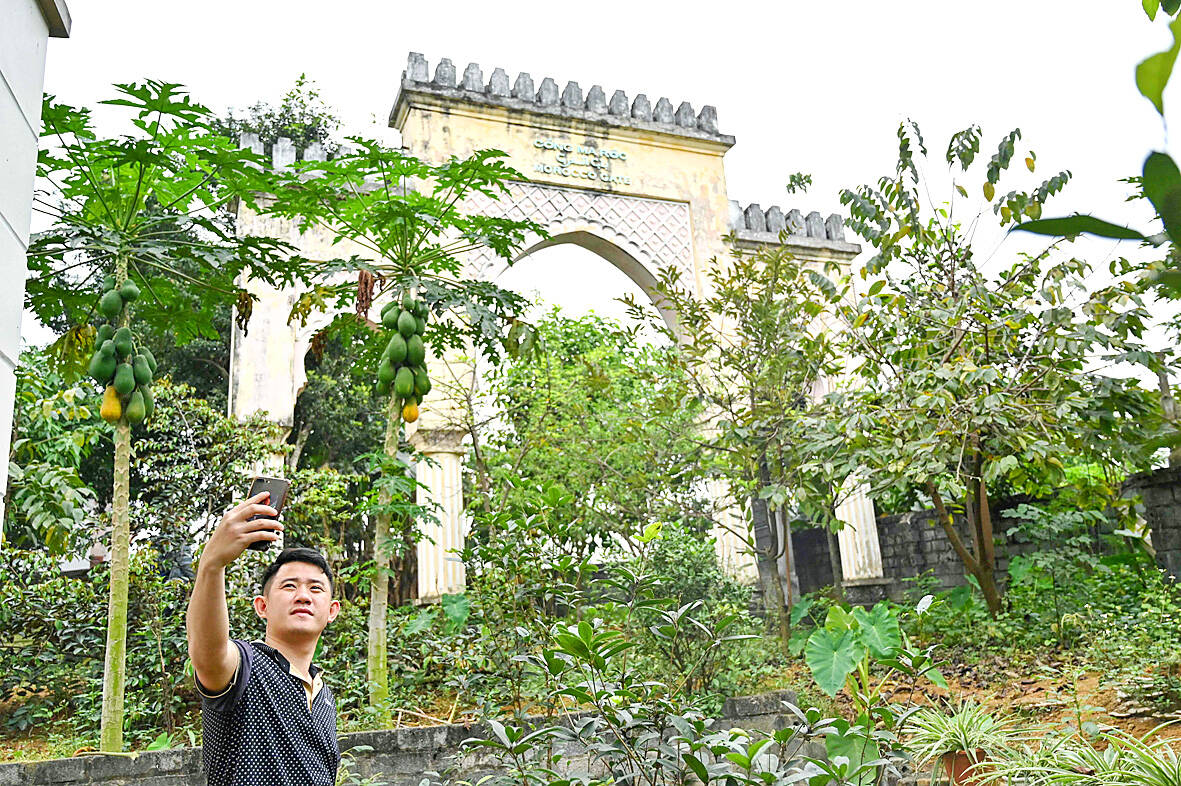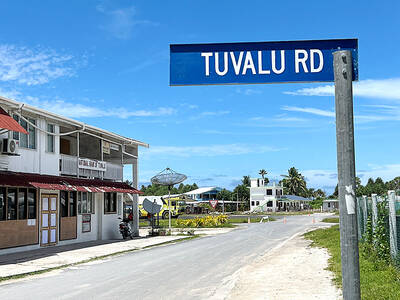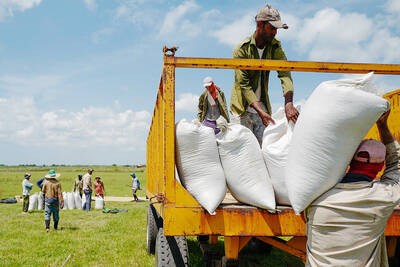Le Tuan Binh keeps his Moroccan soldier father’s tombstone at his village home north of Hanoi, a treasured reminder of a man whose community in Vietnam has been largely forgotten.
Mzid Ben Ali, or “Mohammed” as Binh calls him, was one of tens of thousands of North Africans who served in the French army as it battled to maintain its colonial rule of Indochina.
He fought for France against the Viet Minh independence movement in the 1950s, before leaving the military — as either a defector or a captive — and making a life for himself in Vietnam.

Photo: AFP
“It’s very emotional for me,” said Binh, 64, holding the tombstone.
There was no funeral when his father died in 1968, as the war with the US was in full swing, and his body has since disappeared, but Binh has kept the stone slab, engraved with his father’s nationality: “Moroccan.”
From 1947 to 1954, more than 120,000 North Africans served in the French army in Indochina. Half were from Morocco — which was then a protectorate of France — and of those, about 150 remained in Vietnam after the armistice in 1954, either as defectors or prisoners, including Binh’s father. His story offers a little-known perspective on the First Indochina War as Vietnam and France prepare to commemorate the 70th anniversary of the Battle of Dien Bien Phu on May 7.
The bloody eight-week struggle in the country’s northwestern hills — won decisively by the Viet Minh — was the climactic confrontation that ultimately brought an end to the French empire in Indochina.
In France, “the history of heroism at Dien Bien Phu was for a long time the preserve of white people, who represented the majority of commanders,” said Pierre Journoud, professor of contemporary history at Paul Valery-Montpellier University.
“But after 1947, the war effort relied on colonial riflemen, and they represented the majority of troops,” he said. “We’ve lost part of their story.”
At his home in the northern province of Phu Tho, 80km northwest of Hanoi, Binh makes a pot of black tea spiked with mint leaves from his garden — “Moroccan style, but without the sugar,” he jokes.
In the village, he is nicknamed “the foreigner,” but those close to him call him Ali, the name given to him by his father. The war with the US and economic development have dispersed the Moroccan-Vietnamese families who lived in the country several decades ago.
Some returned to Morocco in the 1970s, but Binh wanted to stay with his Vietnamese mother and two brothers, Boujamaa and Abdallah.
Vietnamese propaganda presented foreign deserters as pioneers in the struggle of oppressed peoples against imperialism, but French researchers say that their motives were usually linked to better pay or fear of punishment for misconduct.
After 1954, Hanoi said about 300 “African and European surrendered soldiers” settled in a farming village in the Ba Vi district, about 50km from Hanoi.
It was in Ba Vi that Binh’s father met his Vietnamese wife and Binh was born in 1959. The farm was dismantled in the 1970s, during the tumult of the war against the US, but today, a Moorish-inspired gateway remains, built by Moroccan workers as a tribute to their country of origin.
The monument stands in the garden of a family that welcomes a handful of visitors every month, and who have ensured its survival over the years.
Binh has struggled for recognition of his past for many years. In 2016, he finally obtained a Moroccan passport, as did his two children, born to a Vietnamese mother, under a surname chosen by the embassy: El Mekki.
His daughter Leila, aged 36, now lives in Casablanca, but Binh has never set foot in Morocco.
“Now I’m too old. I gave the opportunity to my daughter,” he said. “I’m happy now that some of my dreams have come true.”

FORUM: The Solomon Islands’ move to bar Taiwan, the US and others from the Pacific Islands Forum has sparked criticism that Beijing’s influence was behind the decision Tuvaluan Prime Minister Feletei Teo said his country might pull out of the region’s top political meeting next month, after host nation Solomon Islands moved to block all external partners — including China, the US and Taiwan — from attending. The Pacific Islands Forum (PIF) leaders’ meeting is to be held in Honiara in September. On Thursday last week, Solomon Islands Prime Minister Jeremiah Manele told parliament that no dialogue partners would be invited to the annual gathering. Countries outside the Pacific, known as “dialogue partners,” have attended the forum since 1989, to work with Pacific leaders and contribute to discussions around

END OF AN ERA: The vote brings the curtain down on 20 years of socialist rule, which began in 2005 when Evo Morales, an indigenous coca farmer, was elected president A center-right senator and a right-wing former president are to advance to a run-off for Bolivia’s presidency after the first round of elections on Sunday, marking the end of two decades of leftist rule, preliminary official results showed. Bolivian Senator Rodrigo Paz was the surprise front-runner, with 32.15 percent of the vote cast in an election dominated by a deep economic crisis, results published by the electoral commission showed. He was followed by former Bolivian president Jorge “Tuto” Quiroga in second with 26.87 percent, according to results based on 92 percent of votes cast. Millionaire businessman Samuel Doria Medina, who had been tipped

Outside Havana, a combine belonging to a private Vietnamese company is harvesting rice, directly farming Cuban land — in a first — to help address acute food shortages in the country. The Cuban government has granted Agri VAM, a subsidiary of Vietnam’s Fujinuco Group, 1,000 hectares of arable land in Los Palacios, 118km west of the capital. Vietnam has advised Cuba on rice cultivation in the past, but this is the first time a private firm has done the farming itself. The government approved the move after a 52 percent plunge in overall agricultural production between 2018 and 2023, according to data

ELECTION DISTRACTION? When attention shifted away from the fight against the militants to politics, losses and setbacks in the battlefield increased, an analyst said Recent clashes in Somalia’s semi-autonomous Jubaland region are alarming experts, exposing cracks in the country’s federal system and creating an opening for militant group al-Shabaab to gain ground. Following years of conflict, Somalia is a loose federation of five semi-autonomous member states — Puntland, Jubaland, Galmudug, Hirshabelle and South West — that maintain often fractious relations with the central government in the capital, Mogadishu. However, ahead of elections next year, Somalia has sought to assert control over its member states, which security analysts said has created gaps for al-Shabaab infiltration. Last week, two Somalian soldiers were killed in clashes between pro-government forces and